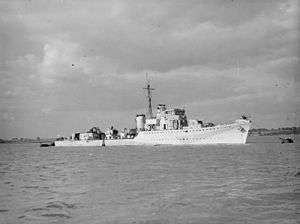HMS Eglinton (L87)
HMS Eglinton (L87) was a Type I Hunt-class destroyer of the Royal Navy built by Vickers-Armstrongs on the River Tyne, and launched on 28 December 1939. She was adopted by the town of Alton, Hampshire, as part of the Warship Week campaign in 1942.
 HMS Eglinton, c1942 | |
| History | |
|---|---|
| Name: | HMS Eglinton |
| Ordered: | 21 March 1939 |
| Builder: | Vickers-Armstrongs, River Tyne |
| Yard number: | Admiralty Job No.J4091 |
| Laid down: | 8 June 1939 |
| Launched: | 28 December 1939 |
| Completed: | 28 August 1940 |
| Identification: | pennant number: L87 |
| Honours and awards: |
|
| Fate: | Scrapped in May 1956 |
| Badge: | On a Field Red, two hunting horns in saltire and three annulets interlaced Gold |
| General characteristics | |
| Class and type: | Type I Hunt-class destroyer |
| Displacement: |
|
| Length: | 85 m (278 ft 10 in) o/a |
| Beam: | 8.8 m (28 ft 10 in) |
| Draught: | 3.27 m (10 ft 9 in) |
| Propulsion: |
|
| Speed: |
|
| Range: |
|
| Complement: | 146 |
| Armament: |
|
Service history
Eglinton served with the 16th Destroyer Flotilla at Harwich for the whole of her wartime service. She was involved in two actions with German S-Boats whilst escorting East coast convoys. She also was part of the support force for the Normandy landings.[1]
After August 1945 she was decommissioned and placed in reserve at Harwich.[2] On 24 June 1955 she was designated as a trials ship for exercise 'Sleeping Beauty' designed to test the state of ships held in reserve, and the time taken to bring them forward for service in the active fleet. She was sold for scrapping and arrived for scrapping at Blyth by Hughes Bolckow on 28 May 1956.
References
- English, John (1987). The Hunts. Cumbria: World Ship Society. ISBN 0-905617-44-4.
- Critchley, Mike, "British Warships Since 1945: Part 3: Destroyers", Maritime Books: Liskeard, UK, 1982. ISBN 0-9506323-9-2, page 24
Publications
- Colledge, J. J.; Warlow, Ben (2006) [1969]. Ships of the Royal Navy: The Complete Record of all Fighting Ships of the Royal Navy (Rev. ed.). London: Chatham Publishing. ISBN 978-1-86176-281-8.
- English, John (1987). The Hunts: a history of the design, development and careers of the 86 destroyers of this class built for the Royal and Allied Navies during World War II. England: World Ship Society. ISBN 0-905617-44-4.